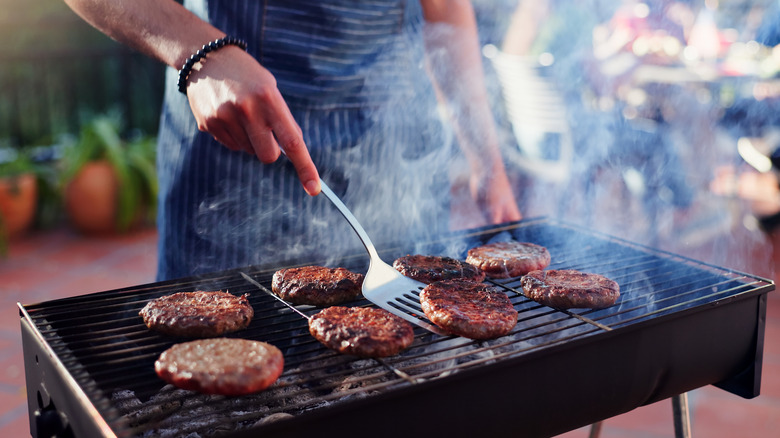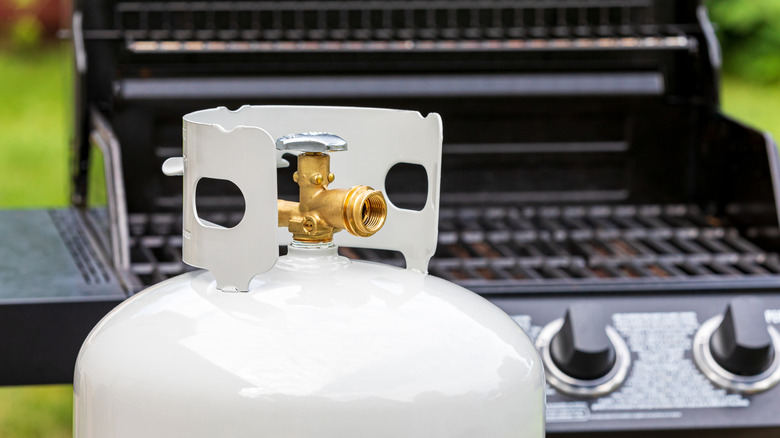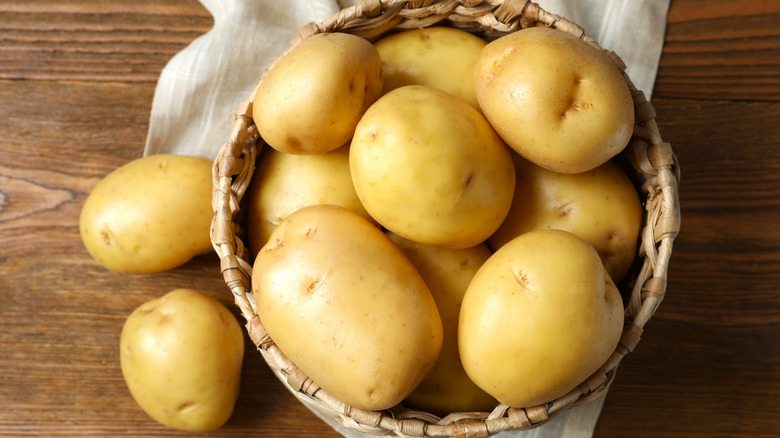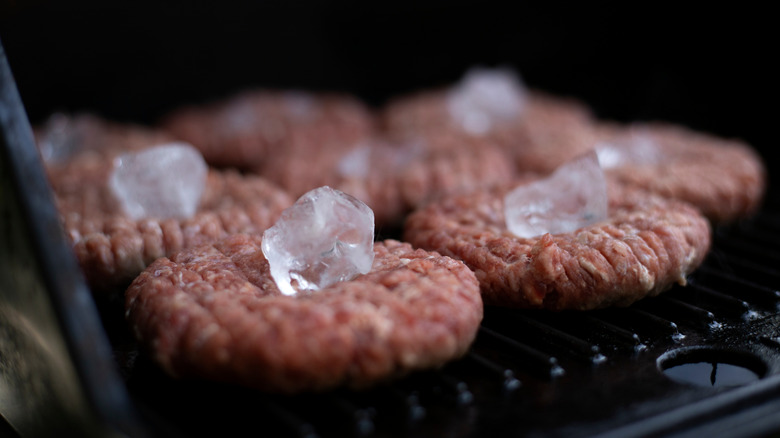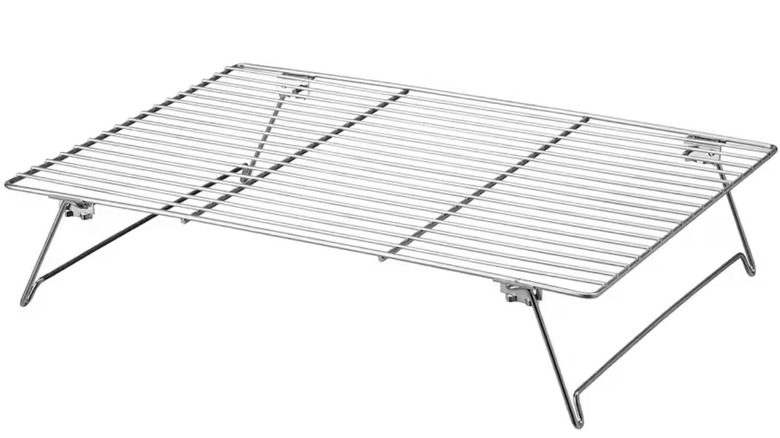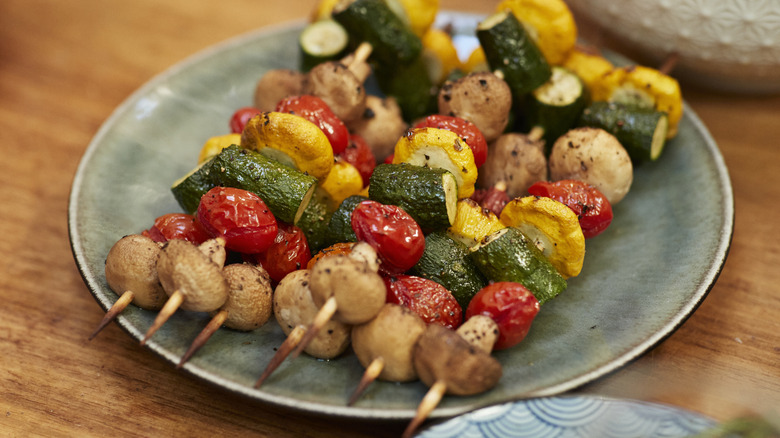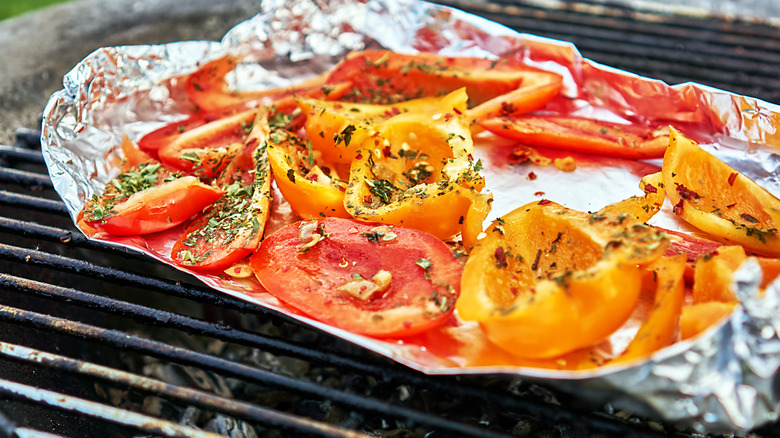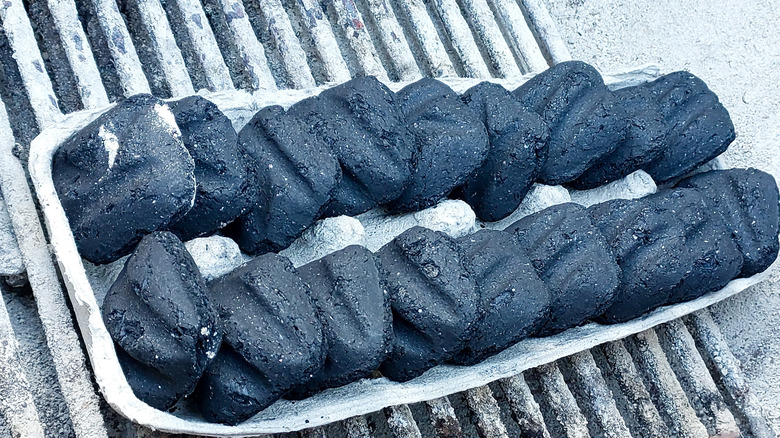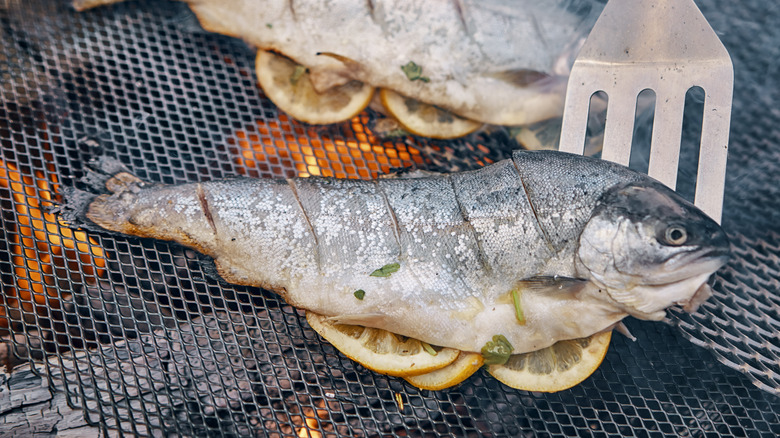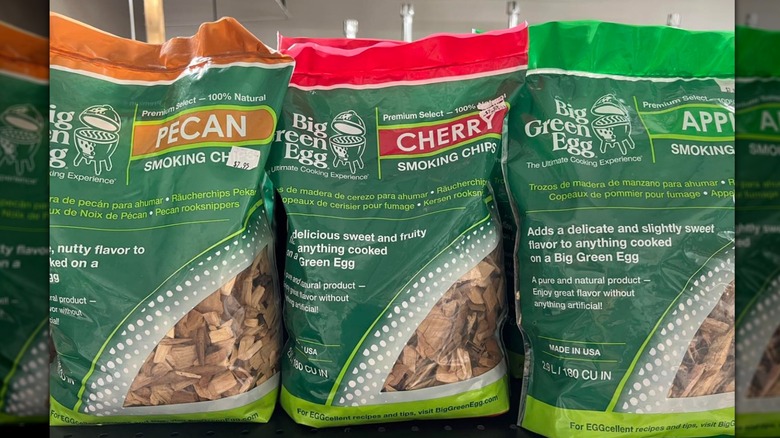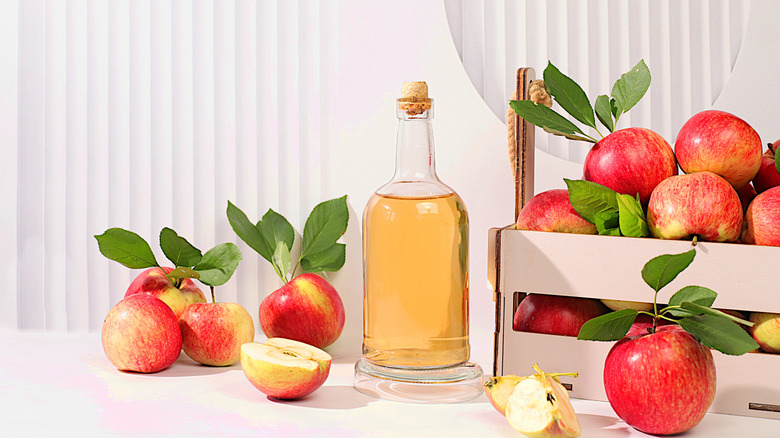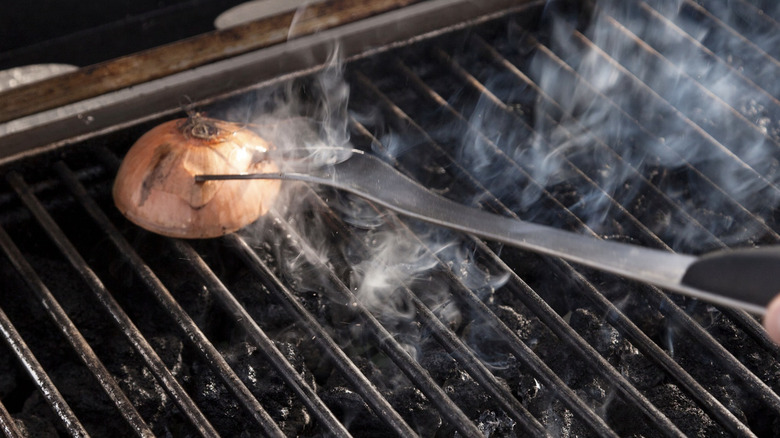Hacks That Will Come In Handy For Grilling Season
The grilling season is all about sharing quality food with friends and family in the open air. It's a time when warm weather, sizzling fare, and good company combine to turn cooking into much more than just another task on your list of things to do. While it's easy to get swept up in the excitement of it all, it's also important to ensure that your grill is ready for action. After all, even the highest quality meats, fish, and vegetables can end up ruined without the right preparation and grilling strategy.
Whether your grill runs on propane, natural gas, or charcoal, there are several universal tips that can make or break your outdoor cooking experience — not to mention your meal. Whether it's cleaning the grates properly or using slices of bread to spot hot zones, there are plenty of simple steps that can make a big difference to your grilling game.
From grilling whole chickens and burger patties that are best with no mix-ins to vegetable skewers, a little know-how can go a long way. With this in mind, take a look at our roundup of top hacks that will help you cook like a pro this grilling season.
Use a glass of water to gauge the level of propane in the tank
Propane is a commonly used fuel for gas grilling. Unlike natural gas grills, which require a dedicated line, propane grills can be easily moved from one location to another. All you need to spark them up is a propane tank. Not just portable, propane grills are also more energy efficient than their natural gas counterparts, since propane delivers about twice as much energy as natural gas.
Since most standard propane tanks don't feature built-in gauges, it's easy to find yourself scrambling with an empty tank. Luckily, checking how much propane is left in the tank doesn't have to be difficult, even if you haven't gotten around to buying a propane gauge or monitor. Did you know that you can estimate propane levels with just a cup of water? To do this, pour a cup of hot water down the outside of the tank. Then run your hand along the water trail. The point where the metal changes from hot to cold is where the propane level sits. If the tank is down to around 20% full, it's a good idea to top it up before embarking on the next cooking session.
Before each grilling season, it's also important to inspect the propane tank and gas lines for any damage. To check for leaks, mix water with dish soap and pour it over the connection. Turn on the gas without igniting the grill. Any bubbles that appear are an indication of a leak that must be fixed before the grill is used.
Prevent food from sticking to the grill with a raw potato
There are several reasons why your food might be sticking to the grill. One possibility is that the grates haven't been properly preheated, preventing the surface of the food from caramelizing. Sticking is also common if the grill or food isn't lightly oiled, especially when it comes to delicate proteins like fish or chicken. While preheating the grill and oiling your food can go a long way toward preventing the food from adhering to the grill, there is another method to ensure smooth cooking. For a natural solution to sticking, consider rubbing the grill grates with a raw potato.
Wiping the grates with a cut-up potato before placing your food on the grill leaves behind a layer of starch, creating a non-stick barrier. For optimal results, preheat the grill, cut the potato in half, and rub it over the grates — you can even skewer the potato to make handling easier. Of course, it goes without saying that the grill should be clean before you begin, as any dirt on the grates may reduce the effectiveness of the starch coating. Once done, simply cut off the side of the potato that touched the grill and use it to make side dishes like mashed potatoes or French fries.
Place an ice cube in the center of your burger patty to lock in moisture
There is nothing worse than a dry, overcooked burger patty. This is why it's important to always monitor the grilling temperature and keep an eye on the clock when grilling. It's also why you might wish to refrain from pressing the patty down with a spatula while it cooks, since pressure is likely to squeeze out the flavorful juices hidden inside the beef.
Another grilling hack for ensuring juicy burgers involves an ice cube. Placing a cube of ice in the center of a beef patty can help prevent it from drying out on the grill. This is because the melting ice adds moisture to the beef as it cooks. Alternatively, you can mix ground beef with ice water prior to grilling (three tablespoons per pound of beef should do the trick) to distribute moisture more evenly throughout the patty.
If the idea of mixing beef and ice cubes or ice water doesn't appeal, there are other ingredients that can help keep your burger patties moist. One is mixing burger beef with liquids like broth, soup, or drippings. Another involves combining the patty with creamy ingredients such as butter, mayonnaise, or even sour cream.
Transform a heat-resistant cooling rack into a grill basket for cooking smaller items
Just as their name suggests, cooling racks are usually used to cool baked goods such as cookies, cakes, and breads. These handy kitchen tools feature a raised design that lets air circulate around the food, letting it rest without trapping steam. Unfortunately, not many home chefs realize that cooking racks can also be used as a grilling accessory.
To maximize effectiveness, place the wire utensil directly on the grill grates to create a second cooking surface. This solution is particularly useful for grilling smaller items such as sliced vegetables that might fall through the gaps in the grill. That said, it's important to ensure that the cooling rack is made from an oven-safe material, such as stainless steel or chrome-plated steel-core. Placing cooling racks with rubberized coating on the grill is a huge no-no since they aren't designed for high-temperature cooking. To prevent the food from sticking, oil the cooling rack lightly, just as you would regular grill grates.
Freeze wooden skewers soaked in water to stop them from burning
From chicken, beef, and shrimp to tofu, peppers, and mushrooms, nearly anything can be cooked on a skewer. Threading bite-sized pieces of food on mini sticks before grilling also makes the food easy to turn, ensuring uniform cooking. The downside to using wooden skewers on the grill is that they can easily burn and even catch on fire.
Luckily, there is an easy solution to keep wooden skewers from burning on the grill — simply soak them in water for at least 30 minutes. You can also go a step further and freeze the soaked skewers before use. This trick won't just reduce the risk of flare-ups, but it can also save you time in the long run. By soaking and freezing a batch of skewers in advance, you will always have ready-to-use skewers on hand. To make things even easier, you can prepare the entire skewers — meat, veggies, and all — in advance and pop them in the freezer. This way, you will have an entire meal prepped and ready to go whenever the fancy strikes.
If you don't have any wooden skewers, try threading your ingredients on fresh rosemary sprigs that have been stripped of their leaves. Not only will they imbue the ingredients with an herbal note, but they can also add visual appeal to the meal if you leave some of the rosemary leaves on one end. Just like with wooden skewers, rosemary sprigs can be soaked in water and frozen to prevent them from burning on the grill.
Grill vegetables in aluminum packets
Few things are more annoying than carefully chopping your vegetables only to watch them fall through the grill grates straight into the flame. Fortunately, there is an easy way to grill your greens, reds, and yellows without sacrificing them to the barbecue gods. Simply place all your chopped veggies on aluminum foil before tossing them on the hot grill grates. You can also form packets out of the foil and place all your veggies inside.
Grilling vegetables in aluminum packets has several advantages. Not only is this method of preparing vegetables fast and easy, but it also simplifies cleanups. Plus, the foil packets will keep the veggies warm while you finish grilling the rest of your meal. Another bonus is that the individually sized veggie packets are ideal for barbecue gatherings — simply hand them out to your guests. Last but definitely not least, aluminum packets are easy to customize with a range of vegetables, herbs, and seasoning, making them a versatile addition to main dishes.
Use a cardboard egg carton filled with charcoal as a fire starter
Many of us have been there — trying to start a charcoal-fueled grill, only to waste time on coals that just won't ignite. Sure, this problem can be easily solved with a questionable fire starter from the supermarket. But, if you want to enjoy clean-tasting food and avoid toxic fumes, it's best to look for a more natural alternative. One simple solution to the problem utilizes a common kitchen throwaway as an accelerant — a cardboard egg carton.
To get the perfect grilling fire going, simply empty a store-bought egg carton and fill the egg cups with lumps of charcoal. Next, light the whole setup to create a stable, uniformly heated base for grilling. As the egg carton catches fire, add more coal as needed. That said, It's important to remember this hack only works with cardboard egg containers. Never set Styrofoam containers on fire, as they will emit toxic fumes that won't just ruin your food but also pose serious health risks if inhaled.
Grill fish on top of citrus slices to protect them from direct heat
Fish can be tricky to grill. Some flaky varieties like cod, pollock, or tilapia are very delicate, which means that they can easily fall apart on the grill. Additionally, fish filets are more likely to stick to the grill grates than their whole counterparts. This often means that you end up tearing the catch off the grill, a maneuver that can easily lead to an unappetizing mess.
Luckily, there is an easy method for keeping your fish intact on the grill. Instead of placing the seafood directly on the grates, lay it on a bed of citrus slices — think lemon, lime, or orange. Not only does this citrusy barrier protect the fish, but it also infuses your filet with a fresh, zesty flavor. If you hate wasting ingredients, you can chop up the grilled citrus slices and use them to add a roasted flavor to salsas or vegetable dishes.
The citrus slice method of grilling fish seems to have passed the test with home chefs. For instance, one happy Reddit user praises the technique, saying, "Grilled lemon is one of my favorite things. The grilling seems to remove much of the acidity and brings out the sugars in the lemon."
Place slices of bread on the grill to identify hot spots
Inconsistent heating can be an issue with many grills. It's not uncommon for gas or charcoal grills to have hot spots or areas where the temperature is significantly higher than on the rest of the cooking surface. Uneven heating, in turn, can affect how the food cooks, leaving some items burnt and others underdone.
The bread test can help you identify whether your grill has hot spots and where they are located. Once you get your grill nice and hot, simply place slices of white bread directly on the grill grates. Leave them there for about a minute before flipping them over. Check the underside of each slice — the darker toast marks indicate hot zones of the grill while the bread with lighter marks points to cooler sections. Once the bread has served its purpose, don't discard it — instead, turn it into croutons or top it with a little garlic butter for a tasty appetizer.
Different heating zones aren't necessarily a drawback when it comes to grilling — with a little forethought, you can use them to your advantage. For instance, searing meat over high heat can give it a beautifully crusty exterior. After searing, move the protein to a cooler section of the grill so it doesn't overcook or dry out. In fact, many professionals strategically divide their grill into direct and indirect cooking zones, with the searing zone located over the flames and the slower-cooking zone off to the side.
Add wood chips to a grill to infuse food with a smoky flavor and aroma
Adding wood chips to a grill can produce aromatic smoke that can enhance the flavor of meats, fish, and vegetables. To incorporate wood chips into your charcoal grill session, simply place the wood over the coals. If you are using a gas or electric grill, place the wood chips in a smoker box. Smoker boxes — which can also be used with charcoal grills — keep the wood chips contained for slow-and-low barbecue sessions.
Wood chips come in a range of flavors and aromas, letting amateur pitmasters tailor the smoke to the particular dish they are making. For example, hickory offers a relatively strong, nutty flavor ideal for flavorful meats such as lamb. Meanwhile, mesquite delivers a bold, slightly bitter flavor profile, and maple gives the food a milder and somewhat sweet taste.
While some grillers swear by soaking the wood chips before use, others prefer using dry chips for faster smoldering. In particular, some experts argue that while water-soaked chips give the appearance of more smoke, they actually don't make much difference to the flavor of the food. That said, one potential benefit of using soaked wood chips is that the extra steam may help keep the meat moist during cooking.
Spray meat with apple juice or apple cider vinegar
Whether you're cooking pork ribs, brisket, or turkey, a little juice can enhance both the flavor and texture of the grilled meat. Spritzing protein with apple juice — or apple cider vinegar — helps to keep the meat tender and juicy as it grills, especially with a low and slow cooking method. It can also give the food subtly sweet and fruity notes as well as promote the formation of a crispy outer crust through caramelization.
For best results, spray the meat every 45 minutes to an hour. Spritzing the protein too often will lengthen the cooking time, while not spraying often enough might wash away the seasoning, leaving the meat overly dry. Too much liquid can also stop the meat from browning. While the best way to dispense the apple juice is with a fine-mist spray bottle, you can also apply it with a basting brush.
If you don't have any apple juice or apple cider vinegar on hand, there are plenty of other staples that can make great substitutes. For instance, beer can imbue the protein with a distinct hoppy flavor and promote caramelization. Spraying meat with beef broth is a great option for those who prefer savory flavors over fruity or sugary notes. Another great option that can elevate the richness of grilled meats is Worcestershire sauce. Known for its bold, savory flavor, this classic condiment can infuse the meat with umami notes without overwhelming its natural flavor.
Clean the grill with an onion
Cleaning the grill after each use not only prolongs the life of the appliance, but it also prevents flare-ups that can burn food during the next cooking session. Leftover bits of food on the grates can also harbor harmful bacteria and even mold. There are several ways to clean a grill, including using store-bought cleaning solutions. Unfortunately, these products often contain chemicals, which might not be ideal for those who prefer a more natural approach.
One method of cleaning a dirty grill that doesn't involve commercial products relies on a halved onion. For optimal results, make sure that the grill is hot, as this will burn off some of the grime and grease. Next, spear the halved onion with a fork and rub it, juicy side down, across the grates. In this case, the bigger the onion, the better, as it will cover more surface area, making your job easier. This hack works because onions contain allicin, which has antibacterial properties. Onions are also packed with natural acids, which are perfect for loosening any stubborn grime.
